HIGH HOLY DAYS
Rosh Hashanah and Yom Kippur are observed during the holiest time of the year for the Jewish people. Join us for this meaningful season of reflection, music, and learning.
One of the main ways we come together as a community at NVHC is celebrating the holidays together. We embrace all members of our community for these celebrations that take place in a variety of settings and formats. From carnival games to text study, meditation to art projects, we join one another throughout the year to eat, sing, learn, and practice Judaism.
Sukkot
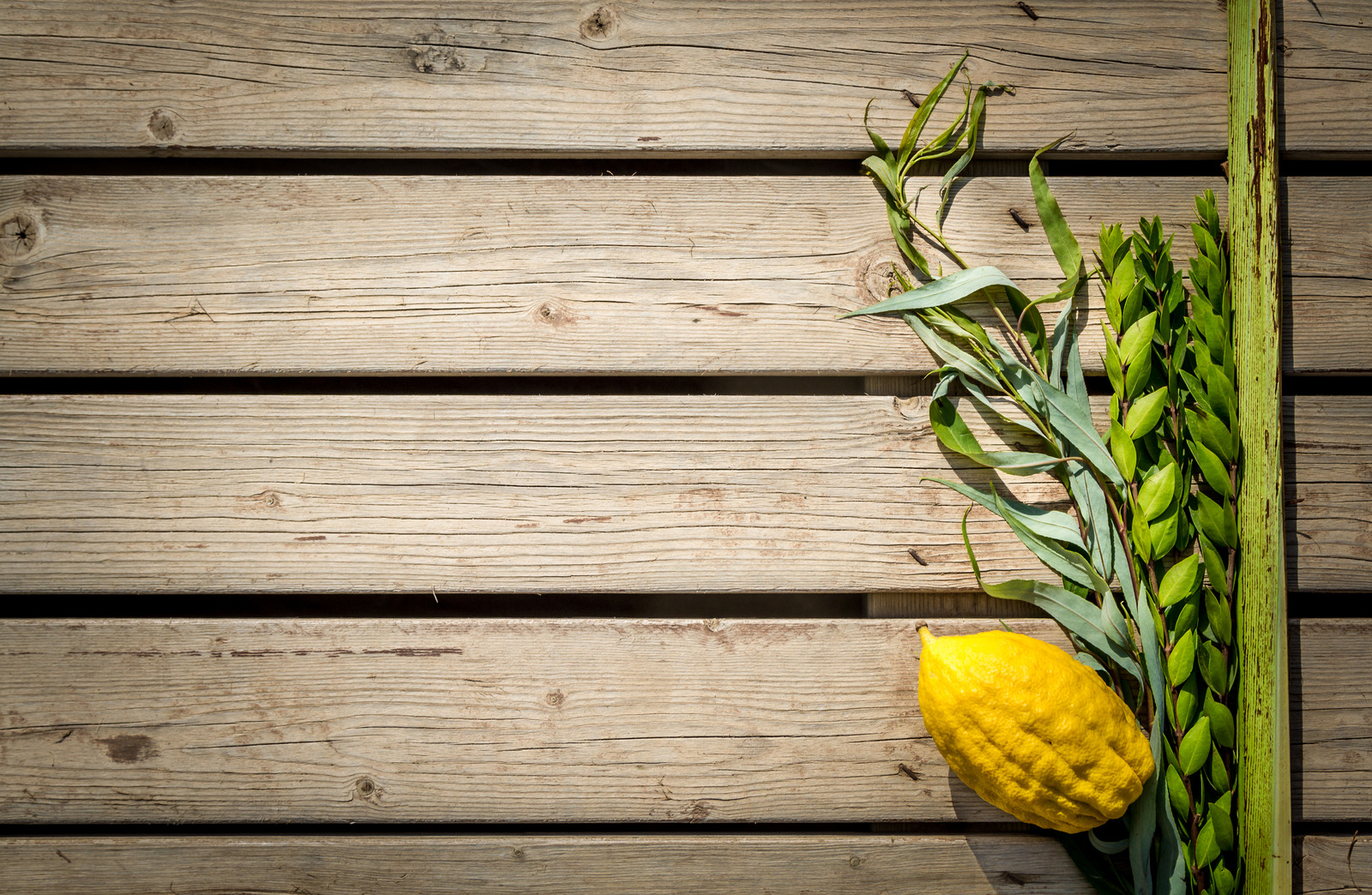
Sukkot, a Hebrew word meaning “booths” or “huts,” refers to the Jewish festival of giving thanks for the fall harvest. It also commemorates the 40 years of Jewish wandering in the desert after the giving of the Torah atop Mt. Sinai. Sukkot is celebrated five days after Yom Kippur, on the 15th of the month of Tishrei, and is marked by several distinct traditions. One, which takes the commandment to dwell in booths literally, is to erect a sukkah, a small, temporary booth or hut. Sukkot (in this case, the plural of sukkah) are commonly used during the seven-day festival for eating, entertaining, and even for sleeping. Sukkot, also called Z’man Simchateinu (Season of Our Rejoicing), is the only festival associated with an explicit commandment to rejoice. A final name for Sukkot is Chag HaAsif, (Festival of the Ingathering), representing a time to give thanks for the bounty of the earth during the fall harvest. Each year, with efforts from the Brotherhood and our NVHC congregants, we construct a sukkah on our property. Often, Tot Shabbat, Kehilat Limmud, our youth groups, or other NVHC constituents will take advantage of Northern Virginia’s beautiful fall weather and eat or spend time together in our sukkah. So, if bright Sukkot morning dawns, bring a cup of coffee and a fresh croissant, and enjoy!
Check our calendar for this year’s Sukkot events!
Simchat Torah
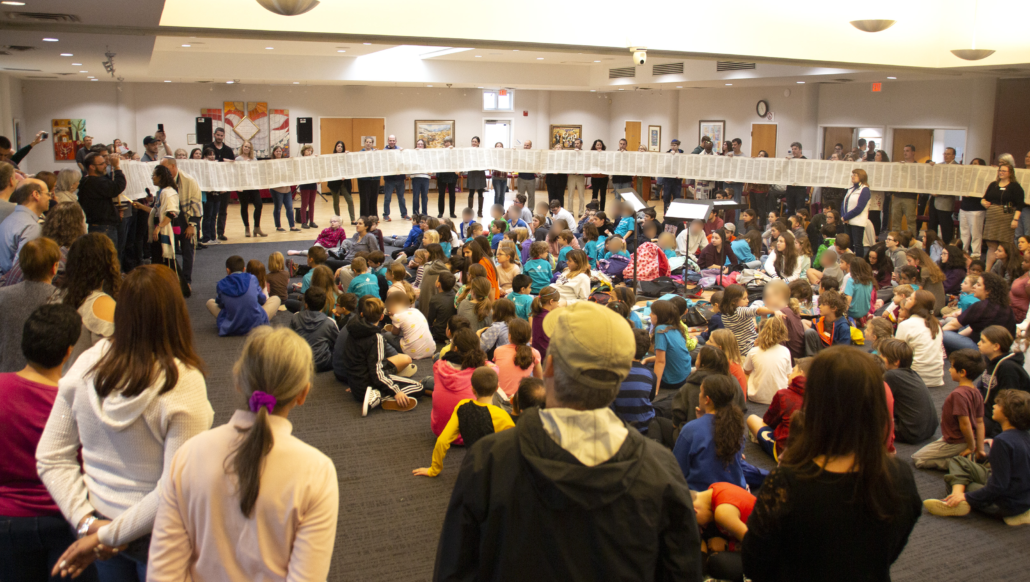 Simchat Torah
Simchat TorahThis festival at the end of Sukkot is a fun-filled day during which we celebrate the completion of the annual reading of the Torah and affirm Torah as one of the pillars on which we build our lives. As part of the celebration, we take our Torah scrolls from the ark and carry them around the synagogue seven times with great joy. As we unroll the entire Torah to envelop our community, we read the concluding section of the fifth book of the Torah, D’varim (Deuteronomy), immediately followed by the opening section of Genesis, B’reishit. This practice represents the cyclical nature of the relationship between the Jewish people and the reading of the Torah. A holiday of dancing with Torahs and waving flags, NVHC’s Simchat Torah service is a true communal celebration.
Chanukah
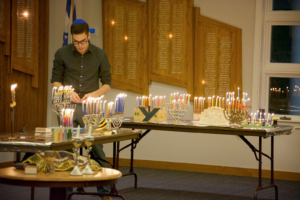 The story of Chanukah reminds us of our people’s ancient quest for freedom and human dignity. People want to know the whole story–what really happened then. Out of the shadows of the past, other pieces of the story are recalled by an individual, here or there. Over time, legends are born and gain strength in the tradition. History tells us how people lived in the past and what they did; legend reveals the hopes, dreams and desires of a people. They inspire us with stories of heroism and greatness. They teach the lessons and the wisdom of the past. It is our never-ending quest to learn. On Shabbat Chanukah, the NVHC community comes together to celebrate the Festival of Lights with our Shabbat Chanukah service. Bring your chanukkiah and lots of candles! It will certainly be the warmest worship service of the year.
The story of Chanukah reminds us of our people’s ancient quest for freedom and human dignity. People want to know the whole story–what really happened then. Out of the shadows of the past, other pieces of the story are recalled by an individual, here or there. Over time, legends are born and gain strength in the tradition. History tells us how people lived in the past and what they did; legend reveals the hopes, dreams and desires of a people. They inspire us with stories of heroism and greatness. They teach the lessons and the wisdom of the past. It is our never-ending quest to learn. On Shabbat Chanukah, the NVHC community comes together to celebrate the Festival of Lights with our Shabbat Chanukah service. Bring your chanukkiah and lots of candles! It will certainly be the warmest worship service of the year.
Tu B’Shevat
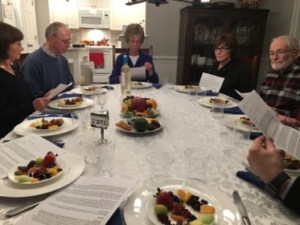 On the 15th day of the month of Shevat, the Jewish community celebrates the holiday of Tu B’Shevat, the “New Year for the Trees”, or Jewish Arbor Day. The holiday is observed on the fifteenth (tu— טו in Hebrew) of the month of Shevat. Scholars believe that Tu B’Shevat was originally an agricultural festival, marking the emergence of spring. After the destruction of the Temple in 70 C.E. and the Diaspora of Jews around the world, this holiday was a way for Jews to symbolically bind themselves to their former homeland by celebrating and eating foods found in Israel. Tu B’Shevat is not mentioned in the Torah, but rather is first described in the Mishnah in the 3rdcentury. Tu B’Shevat has also become a time to celebrate the world of nature around us, to consider our impact on our environment, and what we can do to preserve it. We express our joy and thankfulness for the beauty and fruit of trees which God has created and sustained and renewed. Our ‘tree of life’, our Torah, reminds us of our responsibility to care for God’s world of which we are the custodians, and of our responsibility for sharing the fruits of God’s earth. It becomes our opportunity to express our Jewish commitment to protecting the earth.
On the 15th day of the month of Shevat, the Jewish community celebrates the holiday of Tu B’Shevat, the “New Year for the Trees”, or Jewish Arbor Day. The holiday is observed on the fifteenth (tu— טו in Hebrew) of the month of Shevat. Scholars believe that Tu B’Shevat was originally an agricultural festival, marking the emergence of spring. After the destruction of the Temple in 70 C.E. and the Diaspora of Jews around the world, this holiday was a way for Jews to symbolically bind themselves to their former homeland by celebrating and eating foods found in Israel. Tu B’Shevat is not mentioned in the Torah, but rather is first described in the Mishnah in the 3rdcentury. Tu B’Shevat has also become a time to celebrate the world of nature around us, to consider our impact on our environment, and what we can do to preserve it. We express our joy and thankfulness for the beauty and fruit of trees which God has created and sustained and renewed. Our ‘tree of life’, our Torah, reminds us of our responsibility to care for God’s world of which we are the custodians, and of our responsibility for sharing the fruits of God’s earth. It becomes our opportunity to express our Jewish commitment to protecting the earth.
Purim
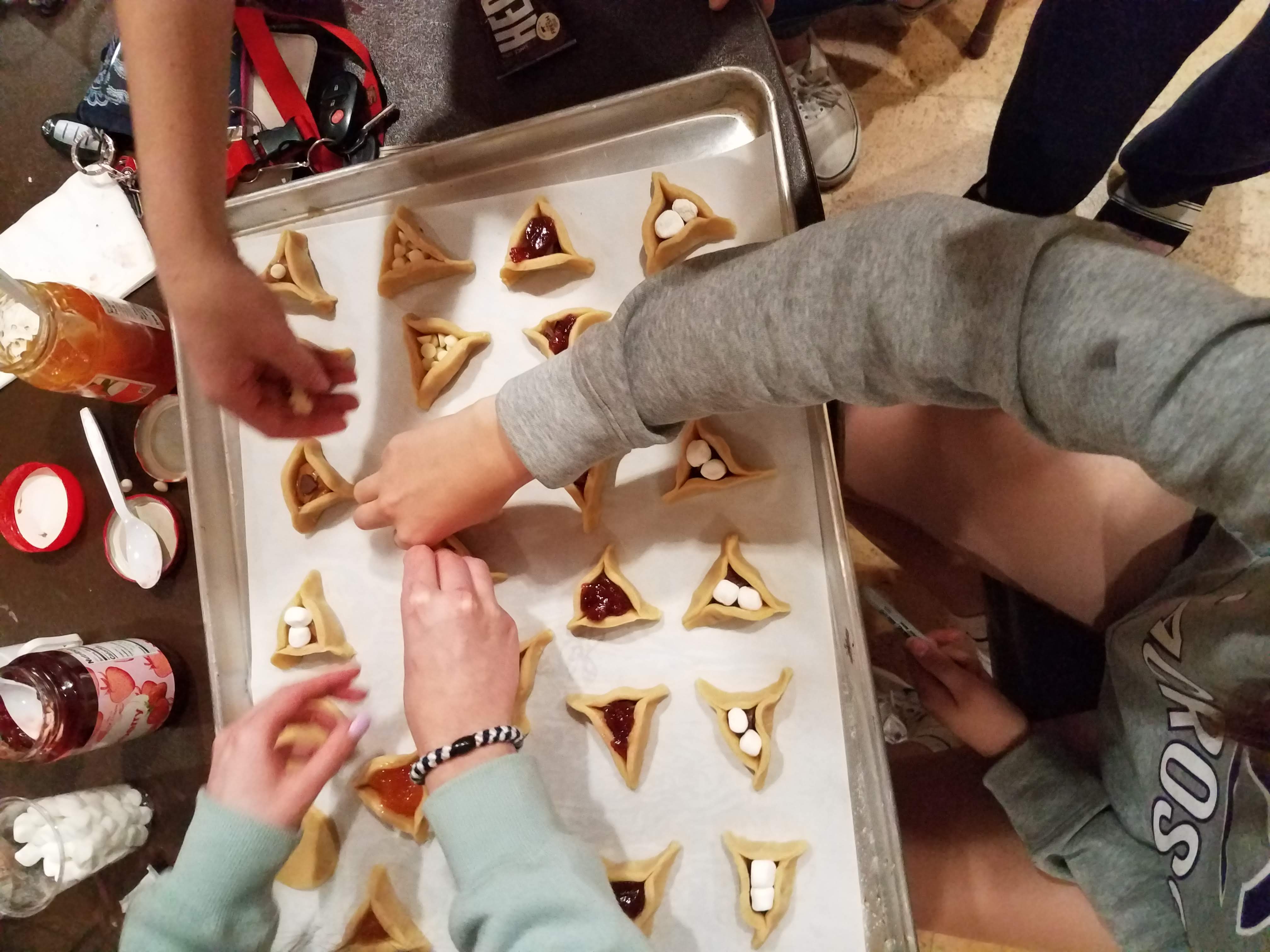 Purim is one of the most joyous and fun holidays on the Jewish calendar. It is celebrated by the reading of the Scroll of Esther, known in Hebrew as the Megillat Esther, which commemorates a time when the Jewish people living in Persia were saved from extermination. Sure to be a ba’alagan (wonderful chaos!), NVHC observes Purim every year with a community Purim celebration or study, our Kehillat Limmud (religious school) Purim Carnival, and our annual Hamantashen Bake-Off! Check our calendar for the details. Eat, Drink, and Be Holy!
Purim is one of the most joyous and fun holidays on the Jewish calendar. It is celebrated by the reading of the Scroll of Esther, known in Hebrew as the Megillat Esther, which commemorates a time when the Jewish people living in Persia were saved from extermination. Sure to be a ba’alagan (wonderful chaos!), NVHC observes Purim every year with a community Purim celebration or study, our Kehillat Limmud (religious school) Purim Carnival, and our annual Hamantashen Bake-Off! Check our calendar for the details. Eat, Drink, and Be Holy!
Pesach
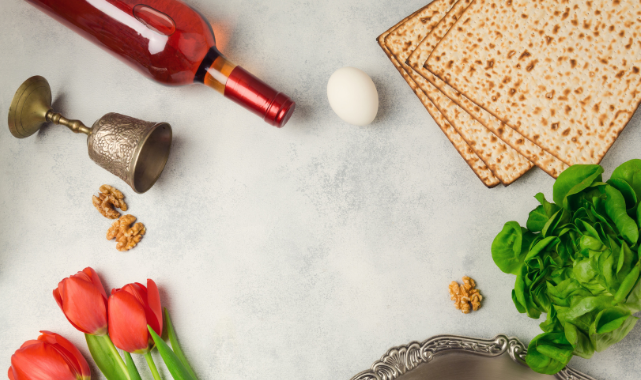 Pesach, known as Passover in English, is a major Jewish spring festival, commemorating the Exodus from Egypt over 3,000 years ago. The ritual observance of this holiday centers around a special home service called the seder (meaning “order”) and a festive meal; the prohibition of chametz (leaven); and the eating of matzah (an unleavened bread). On the eve of the fifteenth day of Nisan in the Hebrew calendar, we read from a book called the haggadah, meaning “telling,” which contains the order of prayers, special symbolic foods and rituals, readings and songs for the Pesach seder. The Pesach seder is the only ritual meal in the Jewish calendar year for which such an order is prescribed, hence its name. The core ideas of Passover are slavery and freedom. During Passover, we celebrate the transition from slavery to freedom. This is eloquently expressed in the rituals and the symbolic items of food on the table, since they have associations with both slavery and freedom. This mesmerizing story of our people’s journey from slavery to freedom includes amazing food, lots and lots of singing, and permission to consume 4 glasses of wine! Join us for our Second Night Community Seder to kick off Pesach!
Pesach, known as Passover in English, is a major Jewish spring festival, commemorating the Exodus from Egypt over 3,000 years ago. The ritual observance of this holiday centers around a special home service called the seder (meaning “order”) and a festive meal; the prohibition of chametz (leaven); and the eating of matzah (an unleavened bread). On the eve of the fifteenth day of Nisan in the Hebrew calendar, we read from a book called the haggadah, meaning “telling,” which contains the order of prayers, special symbolic foods and rituals, readings and songs for the Pesach seder. The Pesach seder is the only ritual meal in the Jewish calendar year for which such an order is prescribed, hence its name. The core ideas of Passover are slavery and freedom. During Passover, we celebrate the transition from slavery to freedom. This is eloquently expressed in the rituals and the symbolic items of food on the table, since they have associations with both slavery and freedom. This mesmerizing story of our people’s journey from slavery to freedom includes amazing food, lots and lots of singing, and permission to consume 4 glasses of wine! Join us for our Second Night Community Seder to kick off Pesach!
Click here to read an article Cantor Caro wrote for the Glance, our newsletter, and listen to a wide variety of music for around Pesach and during your seder.
Yom HaZikaron & Yom Ha’Atzmaut
Yom HaZikaron, is a day of national mourning for Israel’s fallen soldiers and victims of terror, immediately followed by Yom Ha’Atzmaut, a celebration of Israel, statehood, and home.
The iCenter for Israel Education has a whole host of resources on these holidays and everything Israel here.
Watch this video to view a past moment of observance in Israel.
Listen to Israeli music of remembrance.
Explore Israeli music across time periods, genres, and styles.
Lag B’omer
Lag B’omer celebrates the 33rd day of the Omer. Centuries ago, the Romans outlawed the study of Torah at this time of year, so the Jewish people went into the forests to study and gather. Also during that time, a plague struck the Jewish people, but abated on the 33rd day of the Omer. For this reason, we celebrate this day by having Shabbat services in nature! We gather at Lake Fairfax Park for a picnic barbeque meal, music, and a bonfire.
Shavuot
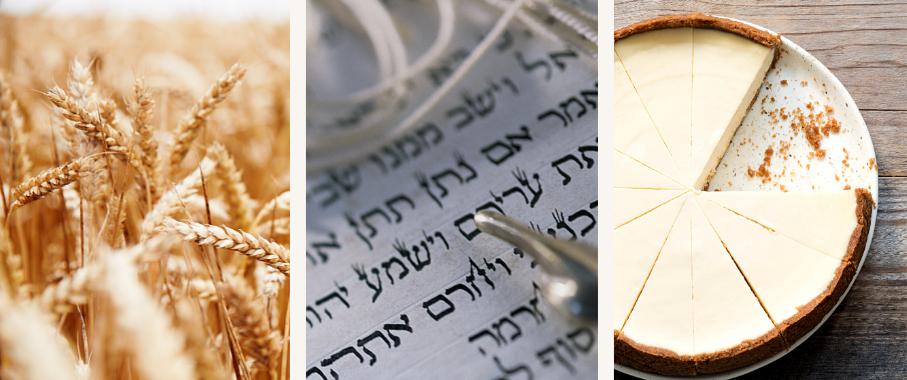 Shavuot is a day of reaffirming the gift of Torah at Mount Sinai, remembering the steadfast love and commitment of Ruth, and partaking of as much cheesecake as any human can stand! We observe this festival with Tikkun Leil Shavuot, a Yizkor service and study sessions for adults as part of our people’s ongoing tradition of valuing Torah and learning. Around the time of Shavuot, we also celebrate Confirmation. This is a communal service where our 10th graders celebrate and affirm their Jewish identity, as connected with Shavuot and the receiving of the Commandments at Mount Sinai. It is a moving and inspiring moment for our entire community to celebrate our vibrant Jewish future represented in these young adults.
Shavuot is a day of reaffirming the gift of Torah at Mount Sinai, remembering the steadfast love and commitment of Ruth, and partaking of as much cheesecake as any human can stand! We observe this festival with Tikkun Leil Shavuot, a Yizkor service and study sessions for adults as part of our people’s ongoing tradition of valuing Torah and learning. Around the time of Shavuot, we also celebrate Confirmation. This is a communal service where our 10th graders celebrate and affirm their Jewish identity, as connected with Shavuot and the receiving of the Commandments at Mount Sinai. It is a moving and inspiring moment for our entire community to celebrate our vibrant Jewish future represented in these young adults.
Tisha B’Av
Tisha B’Av, observed on the 9th of the Hebrew month of Av, marks a day of mourning the destruction of both ancient Temples in Jerusalem. While Tisha B’Av has lessened somewhat in importance as a ritual observance, as the rebuilding of a central Temple in Jerusalem has lost its priority and significance in modern times, Tisha B’Av has become a symbol of Jewish suffering and loss. Although historians dispute the fact that both Temples were destroyed on this day, over the centuries other tragic events have come to be commemorated on this day, including the brutal massacres of the Crusades, the Jewish expulsion from Spain, and the Holocaust. Today, Tisha B’Av stands as a day to reflect on the suffering that still occurs in our world. At NVHC, we acknowledge this day by making available communal study and prayer.
Rosh Hashanah and Yom Kippur are observed during the holiest time of the year for the Jewish people. Join us for this meaningful season of reflection, music, and learning.